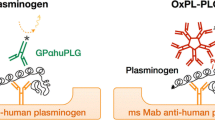Abstract
Background: There is compelling evidence that coronary atherosclerosis represents a chronic active process characterized by inflammation, impaired flbrinolysis, intermittent plaque rupture, and luminal thrombosis. Identifying readily measurable plasma markers of procoagulant activity may have an important role in both tracking and understanding the natural history, as well as in defining the ideal treatment, of patients with coronary artery disease.Methods/Results: A total of 30 men and women with suspected coronary artery disease who underwent outpatient cardiac catheterization were sampled for evidence of thrombin generation and fibrin formation in plasma. Compared with healthy controls, patients had significantly increased concentrations of fibrinopeptide A (18.8±10.8 ng/ml vs. 2.5±2.3, p<0.001), thrombin-antithrombin complexes (8.13±4.56 ng/ml vs. 3.4±3.0, p<0.001), and prothrombin activation fragment 1.2 (0.15±0.09 ng/ml vs. 0.12±0.19, p=0.01). There was a statistically insignificant trend toward increased thrombinantithrombin complex concentrations in patients with hypercholesterolemia (p=0.10). Patients with angiographically defined coronary artery disease involving two or more vessels were found to have heightened thrombin generation and fibrin formation compared with those with single vessel disease.Conclusions: Patients with atherosclerotic coronary artery disease exhibit evidence of heightened procoagulant activity, including thrombin generation and fibrin formation. This observation, coupled with those derived from other recent studies, support the hypothesis that coronary atherosclerosis represents a chronic active process typified by vessel wall inflammation and recurrent thrombosis. Future efforts in disease prevention and treatment must consider these fundamental pathobiologic properties.
Similar content being viewed by others
References
1993 Heart and Stroke Fact Statistics. American Heart Association 1993:1–18.
Treasure CB, Klein JL, Weintraub WS, et al. Beneficial effects of cholesterol-lowering therapy on the coronary endothelium in patients with coronary artery disease.N Engl J Mud 1995;332:481–487.
Blum A, Sclarovsky S, Shohat B. T lymphocyte activation in stable angina pectoris and after percutaneous transluminal coronary angioplasty.Circulation 1995;91:20–22.
Becker RC, Tracy RP, Bovill EG, et al. For the TIMI III Thrombosis and Coagulation Study Group. Surface 12-lead electrocardiographic findings and plasma markers of thrombin activity and generation in patients with myocardial ischemia at rest.J Thromb Thromboly 1994;1:101–107.
Mizuno K, Satomura K, Miy A, et al. Angioscopic evaluation of coronary artery thrombin in acute coronary syndromes.N Engl J Med 1992;326:287–291.
Fernandez-Ortiz A, Badimon JJ, Falk E, et al. Characterization of the relative thrombogenicity of atherosclerotic plaque components: Implications for consequences of plaque rupture.J Am Coll Cardiol 1994;23:1562–1569.
Merlini PA, Bauer KA, Oltrona L, Ardissino D, Cattaneo M, Belli C, Mannucci PM, Rosenberg RD. Persistent activation of coagulation mechanism in unstable angina and myocardial infarction.Circulation 1994;90:61–68.
DiSciascio G, Cowley MJ, Goudreau E, Vetrovec GW, Johnson DE. Histopathologic correlates of unstable ischemic syndromes in patients undergoing directional coronary atherectomy: In vivo evidence of thrombosis, ulceration, and inflammation.Am Heart J 1994;128:419–426.
Sullivan E, Kearney M, Isner JM, Topol EJ, Losordo DW. Pathology of unstable angina: Analysis of biopsies obtained by directional coronary atherectomy.J Thromb Thromboly 1994;1:63–71.
Montalescot G, Maclouf J, Drobinski G, Salloum J, Grosgogeat Y, Thomas D. Eicosanoid biosynthesis in patients with stable angina: Beneficial effects of very low dose aspirin.J Am Coll Cardiol 1994;24:33–38.
Cortellaro M, Cofrancesco E, Boschetti C, Mussoni L, Donati MB, Catalano M, Gabrielli L, Lombardi B, Specchia G, Tavazzi L, Tremoli E, Turri M, and The PLAT Group. Association of increased fibrin turnover and defective fibrinolytic capacity with leg atherosclerosis.Thromb Haemost 1994;72:292–296.
Ridker PM, Hennekens CH, Cerskus A, Stampfer MJ. Plasma concentration of cross-linked fibrin degradation product (d-dimer) and the risk of future myocardial infarction among apparently healthy men.Circulation 1994;90:2236–2240.
Thompson SG, Kienast J, Pyke SD, et al. For the European Concerted Action on Thrombosis and Disabilities Angina Pectoris Study Group. Hemostatic factors and the risk of myocardial infarction or sudden death in patients with angina pectoris.N Engl J Med 1995;332:635–641.
Théroux P, Latour J-G, Léger-Gauthier C, De Lara J. Fibrinopeptide A and platelet factors level in unstable angina pectoris.Circulation 1987;75:156–162.
Szczeklik A, Dropinski J, Radwan J, Krzanowski M. Persistent generation of thrombin after acute myocardial infarction.Arterioscleros Thromb 1992;12:548–553.
Bauer KA. Laboratory markers of coagulation activation.Arch Pathol Lab Med 1993;117:71–77.
Peltzer H, Schwarz A, Heimberger N. Determination of human thrombin-antithrombin III complex in plasma with an enzyme-linked immunosorbent assay.Thromb Haemost 1988;59:101–106.
Marmur JD, Merlini PA, Sharma SK, et al. Thrombin generation in human coronary arteries after percutaneous transluminal balloon angioplasty.J Am Coll Cardiol 1994;24:1484–1491.
Author information
Authors and Affiliations
Rights and permissions
About this article
Cite this article
Rho, R., Tracy, R.P., Bovill, E.G. et al. Plasma markers of procoagulant activity among individuals with coronary artery disease. J Thromb Thrombol 2, 239–243 (1995). https://doi.org/10.1007/BF01062716
Issue Date:
DOI: https://doi.org/10.1007/BF01062716




